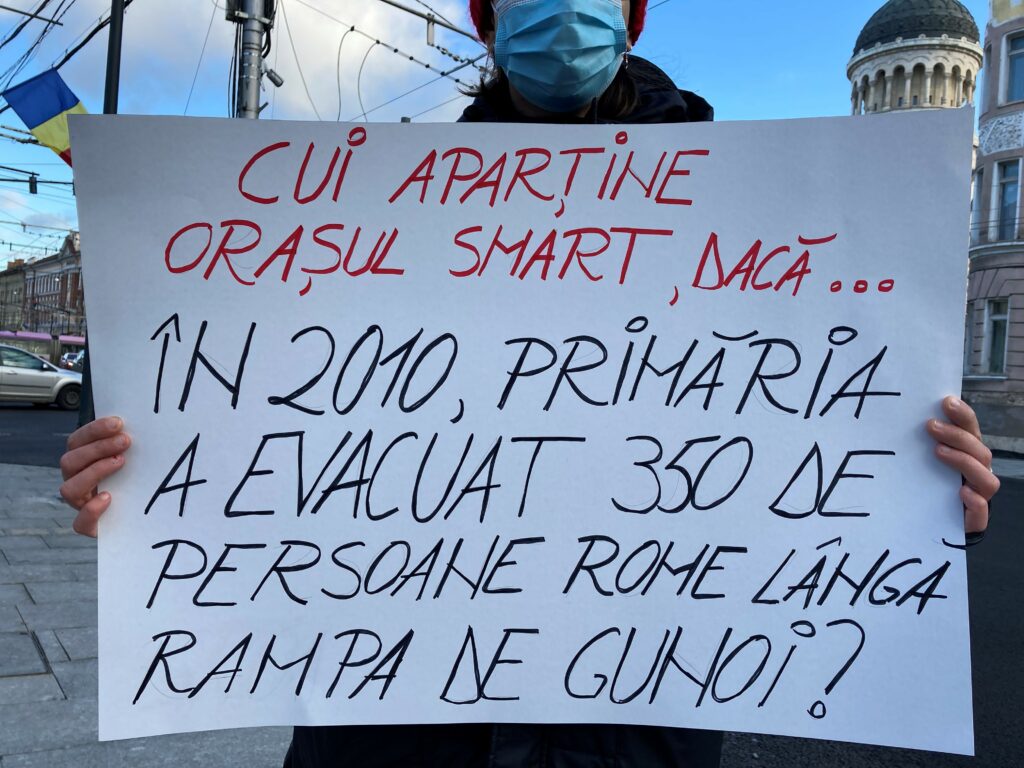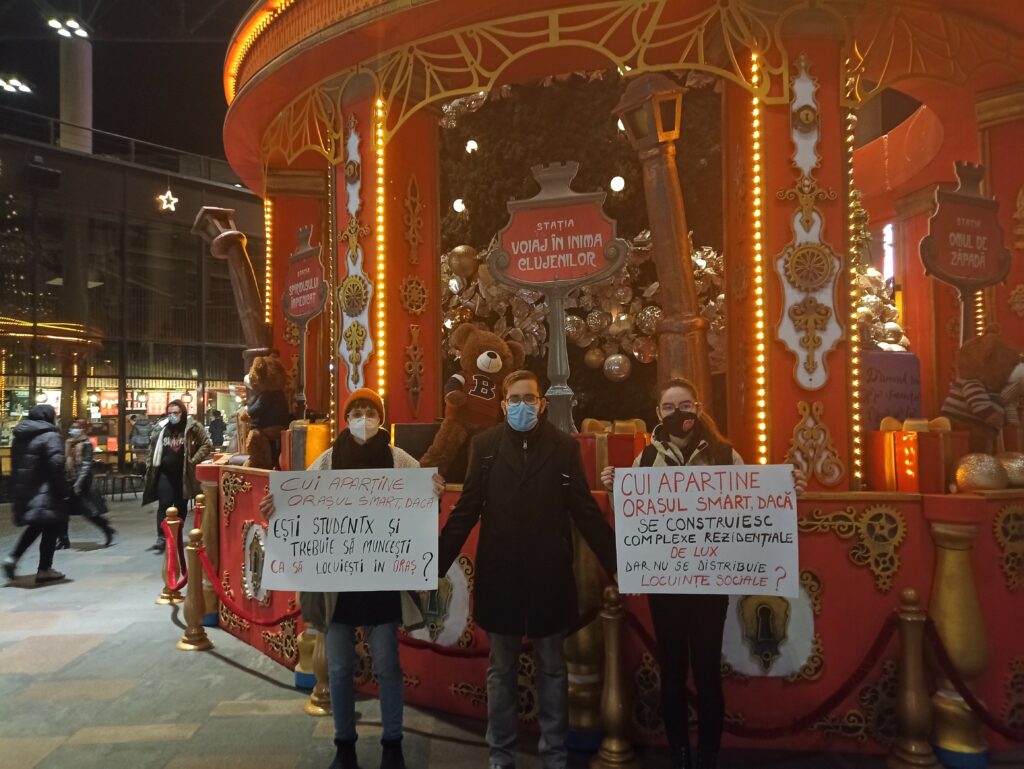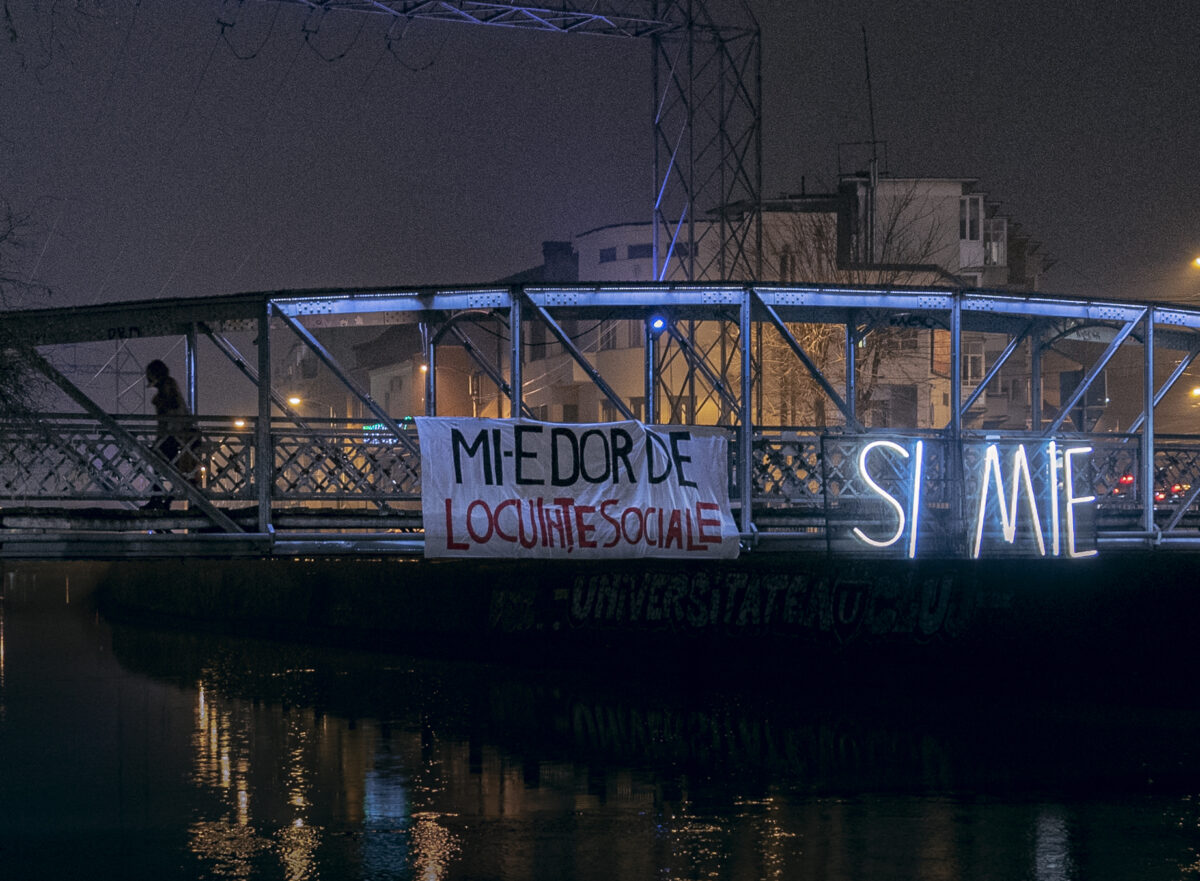Note from LeftEast editors: We are publishing the press release of the Romanian Social Housing NOW! (Căşi sociale ACUM!) radical housing justice movement based in Cluj-Napoca. They organized a hybrid, online and physical, action day on 17th December, commemorating the eviction of 350 Roma people that happened on the same day 11 years ago. The photographed street actions where framed around the question ‘To whom does the smart city belong, if…?’ and they also created a pop-up exhibition presenting the Eviction Monument they plan to place at the site of the 2010 eviction.
On 17th December 2021, we welcomed the support of the local press and social media, which highlighted the actions of Social Housing NOW! carried out on the commemoration of the eviction in 2010 of 350 Roma people and their forced relocation to the landfills of Pata Rât. The citizens of the ‘smart city’ showed that they miss social housing – a banner with the text “I miss social housing” was hung on a bridge, near a light sculpture that says “me too”.
Through the actions “Online march: To whom does the city belong to?”, The Social Housing NOW! team re-launched many of the messages that have drawn attention to the housing crisis in Cluj over the last decade. Activists from the movement went in front of local institutions or well-known public places in Cluj, with banners asking the question ‘To whom does the smart city belong to, if…?’ The photos were redistributed hundreds of times on social media throughout the weekend – showing that housing is not only a common cause, but also a problem in our ‘smart’ city. A problem that affects us all, those of us who pay far too much rent, who live in overcrowded or unsafe apartments with limited access to basic utilities.
See more photos on the Social Housing NOW! Facebook page here.
*
In the evening, we took part in a flashmob (see our live video here) which presented the exhibition ‘Where did the children from the couch go?’
As this picture taken by Paula Boarță shows, when they lived on Coastei Street, people used to go out on the couch in the summer. In front of them, in Mărăști Square the following buildings got erected: the new headquarters of the Octavian Goga Library (2002); Olimpia Business Center (2006); the building of the Cluj Regional Customs on the town hall land (2005), which was then taken over and completed by the Cluj County Council (May 2010). And behind them, new villas were being built on Inău Street. Among others, that of the interim mayor Sorin Apostu, who ordered the demolition and evacuation of Coastei Street in 2010, and who, in November 2011, was arrested for taking bribes in order to issue building permits.
In 2009, the sofa where several children used to sit was placed in the spot where we now, in 2021, propose the location of the Eviction Monument on Coastei Street. In December 2010 the couch disappeared and so did the children sitting on it. They were dumped near the city’s landfill. The monument reminds us of this eviction. Let’s not forget, so that it never happens to anyone again!

After the eviction of December 2010, several buildings were built in the area where the 76 Roma families used to live: a building of the Faculty of Orthodox Theology of the Babeș-Bolyai University – campus and church, on the city hall’s land (May – December 2011); a public nursery called the Wizard of Oz (2016); to so-called ‘Dorobantilor Residence’, a 12-storey building on Dorobantilor Street, with 120 ‘premium apartments’ and 120 parking spaces, built by Transilvania Constructions. Today, the price for such apartments is 2000 euro / sqm and 10000 euro for a garage.
“When I come here and look at everything that is here and what is around now, honestly, I have to say that it is beautiful, clean, it smells good. But what is not so beautiful is that everything that has been done, has been done on the suffering and on the tears of others. But that’s the way people are, they only look after their own well-being, even if they push others out of the way. They don’t care who was left behind in tears, who was beaten. These things could have been done in a different way, not necessarily with the suffering, sorrow and tears from so many people. They could have come and tell us, we don’t like how this place looks like, we want to clean it, but we are also moving you to a place where you will be well, not to suffering and torment”. (Silviu Zsiga, former resident of Coastei Street)

The exhibition ‘Where did the children from the couch go?’ places in context the need of the Roma community that lived until 2010 on Coastei Street to symbolically mark the place from where it has been evicted and forcibly moved to Pata Rât, near the city’s landfills. The organisations involved came up with the idea of creating a work of art that would remind the community of this moment and draw attention to the fact that forced evictions in Cluj must stop. Artists and members of the community created a 3D replica of the area which was demolished in 2010. Together we propose the placement of the Eviction Monument from Coastei Street on the current Episcop Nicolae Ivan Street.
The exhibition is divided into three sections (- you can see the exhibition online in Romanian here):
– The memory of the place in the community on the Coastei street before 2010; the eviction from the Coastei street – lived dramas; the forced relocation to Pata Rât – experiences of trauma.
– A chronology of the ongoing violence enacted by the authorities; The suffering of people in the polluted environment of Pata Rât; Housing justice activism (2010-2021)
– The eviction monument on Coastei Street, under construction; Why did the children disappear from the couch?; The eviction monument – location and architecture.
The artwork for the monument currently consists of a replica of the area that used to be named Coastei Street before the 2010 eviction of Roma families who lived there. This model shows only the demolished houses, and they are reconstructed from the existing plans, photos and, most importantly, from the memories of the inhabitants. Activist Enikő Vincze from Social Housing NOW! facilitated connection between the victims of the eviction and the artists involved pro bono in the construction of the monument. Through successive meetings with community members Linda Greta Zsiga, Silviu Zsiga, Alexandru Greta and Elena Greta Rita, the artists modeled the spaces, the ‘barracks’, the street, the vegetation, the equipment used for the eviction, as remembered by the people who used to live there.
The proposed monument (see the picture above) will be placed on an area paved with cubic stone, the plinths of the model and the plate being made of blocks of Viştea stone, and the model of the area as well as the plate will be cast in bronze. The plinths have concrete foundations.
The proposal for the location for the monument is inspired by the photo (shown before) from 2009 with some children from the former Coastei Street, posing on a sofa. The background of the photo is the array of old flats in the Mărăști neighborhood. Later, on Dorobantilor Street, the Octavian Goga County Library was built. The building hides part of the perspective seen on the old picture. The monument is intended to be located at a point from which we can have the same background as in the photo.
In 2022, the creators of the Eviction Monument are counting on the support of everyone in order to place it on the proposed location.
Our struggle goes on, because housing on the market is more and more expensive, the rents have also become too high, we still do not have enough social housing compared to the real need in the city, the forced evictions have not stopped, the real estate chaos is suffocating us. Inequality remains as such also in the digital society (in the ‘smart city’). Many people continue to be subjected to both workplace exploitation and severe housing deprivation, being unable to pay the high costs of living in the city where they work for the minimum income on economy. Meanwhile, the smart industry, an integral part of the post-industrial capitalist economy, is making a big profit for its owners.

